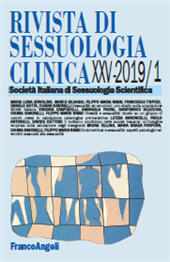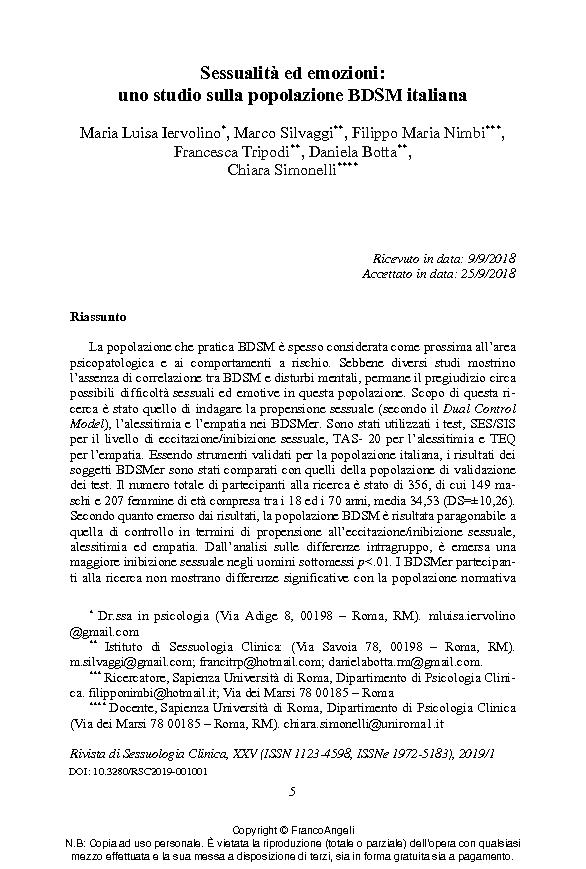2019 - Franco Angeli
Articolo
Versione Digitale
Download | Copia/incolla | Stampa
Sessualità ed emozioni : uno studio sulla popolazione BDSM italiana
5-30 p.
- La popolazione che pratica BDSM è spesso considerata come prossima all'area psicopatologica e ai comportamenti a rischio. Sebbene diversi studi mostrino l'assenza di correlazione tra BDSM e disturbi mentali, permane il pregiudizio circa possibili difficoltà sessuali ed emotive in questa popolazione. Scopo di questa ricerca è stato quello di indagare la propensione sessuale (secondo il Dual Control Model), l'alessitimia e l'empatia nei BDSMer. Sono stati utilizzati i test, SES/SIS per il livello di eccitazione/inibizione sessuale, TAS- 20 per l'alessitimia e TEQ per l'empatia. Essendo strumenti validati per la popolazione italiana, i risultati dei soggetti BDSMer sono stati comparati con quelli della popolazione di validazione dei test.
- Il numero totale di partecipanti alla ricerca è stato di 356, di cui 149 maschi e 207 femmine di età compresa tra i 18 ed i 70 anni, media 34,53 (DS=±10,26). Secondo quanto emerso dai risultati, la popolazione BDSM è risultata paragonabile a quella di controllo in termini di propensione all'eccitazione/inibizione sessuale, alessitimia ed empatia. Dall'analisi sulle differenze intragruppo, è emersa una maggiore inibizione sessuale negli uomini sottomessi p<.01. I BDSMer partecipanti alla ricerca non mostrano differenze significative con la popolazione normativa rispetto alla propensione all'eccitaioe/inibizione sessuale, alla capacità di riconoscere ed esprimere le emozioni e all'empatia. La maggiore tendenza all'inibizione sessuale da parte dei soggetti maschi con ruolo di sottomessi, può essere spiegata dal fatto che, culturalmente, la sottomissione risulta incompatibile con l'identità sessuale maschile stereotipica. [Testo dell'editore]
- The population of people that engages in BDSM activities (acronym that stands for Bondage, Discipline, Sadism and Masochism) has often been considered, from mainstream culture, close to the psychopathological area; has also been connected with the incapacity of controlling sexual instincts, risk behaviors, up to, in some extreme cases, violence and consent violations. Although some new national and international studies showed the lack of correlation between BDSM activities and mental disorders, the prejudice regarding the possible sexual and emotional difficulties related to this population can often remain. The main focus of this research was to investigate the sexual propensity, the level of alexithymia and empathy into an Italian sample of people that engages in BDSM activities.
- As a reference model to assess the sexual propensity has been used the Dual Control Model, which hypothesizes that sexual excitation and behaviors connected to that depends on the balance between sexual excitation and inhibition inside our brains. Alexithymia can be described as a general difficulty of identifying feelings and discriminating one from another, of distinguishing emotions from feelings coming from non-emotional somatic alterations, of a certain level of difficulty in communicating feelings to others. It is also characterized by a stimulus-related cogni-tive style, external oriented, by coerced imaginative processes, with some kind of lack of fantasies. Empathy has been historically defined as the ability to identify yourself in other's mental state and way of thinking, using the comprehension of their emotional signals, the assumption of their subjective prospective, the ability to share their feelings.
- The SIS/SES test has been used to assess the level of sexual inhibition/excitation, the TAS-20 test to assess the level of alexithymia, the TEQ test to assess the level of empathy. Since the majority of these instruments has been already validated for the Italian population, results for the BDSM population were compared with those from the validation population of each test. The total number of participants was 356, 149 males and 207 females, with ages going from 18 and 70, and an average of 34,53 years (SD=±10,26). Considering what emerged from the collected data, the BDSM population is comparable with the control sample in terms of sexual excitation/inhibition propensity, alexithymia and empathy. Regarding the intra-group difference analysis, comparing the three sub-groups divided by BDSM role (Dom, Sub, Switch) and gender, a higher level of sexual inhibition emerged in the subgroup of male submissives p<.01.
- This could be a starting point to further research, with the aim of shedding a light on a population still considered under-ground as the BDMSrs whose fetish and kinky esthetics is getting more and more pervasive in pop culture and mainstream media. [Publisher's text]
Fa parte di
Rivista di sessuologia clinica : 1, 2019-
Informazioni
Codice DOI: 10.3280/RSC2019-001001
ISSN: 1972-5183
PAROLE CHIAVE
- BDSM, emozioni, sadomasochismo, empatia, alessitimia
- BDSM, emotions, sadomasochism, empathy, alexithymia
-
Nello stesso fascicolo
- Sessualità ed emozioni : uno studio sulla popolazione BDSM italiana
- Obesità e sessualità : studio su un gruppo di uomini obesi in valutazione psicologica pre-bariatrica
- Il bullismo omofobico nelle scuole toscane : un'indagine empirica sulla valutazione degli insegnanti
- Endometriosi e sessualità : aspetti psicologici ed emotivi associati alla sessualità
- Recensioni
- Segnalazioni bibliografiche
- Convegni



